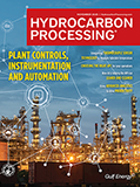Motors
Creating opportunities for future fluid machinery experts
The state of understanding science and facts on one side and distinguishing these from anecdotes and often far-fetched opinions on the other side should be concerning to us. Institutions of higher learning can be disinclined to teach needed, applicable or actionable knowledge.
Electric drive LNG can grow with the clean energy transition
As companies across markets set aggressive decarbonization goals and sustainability commitments to align with changing regulations and consumer demands for greener energy and fuel, the liquefied natural gas (LNG) industry is searching for ways to lower emissions.
Reliability: When to consider liquid-ring compressors
Liquid-ring compressors (FIG. 1) use the centrifugal whirling of a sealing liquid to create a series of piston-like water columns to trap gas or vapor between the impeller cells of a rotor installed eccentric to its casing.
HP Flashback: Excerpts from the 1950s: Capacity expands after WW2 and technologies and maintenance mature
The following is a mixture of technical articles, columns and headlines published in the 1950s by <i>Petroleum Refiner,</i> the forerunner to <i>Hydrocarbon Processing</i>.
Rotating equipment oil systems optimization guideline
The industry is moving away from oil shaft seals and hydraulic speed control for turbines to advanced alternatives.
History of the HPI: The 1930s: Catalytic cracking, polyethylene, synthetic fibers, resins and jet engines
The hydrocarbon processing industry (HPI) has a rich history of discovery, challenges, breakthroughs, trial and error, collaboration and success. <i>Hydrocarbon Processing</i> continues its reflection on the history of the HPI.
Engineering Case Histories: Case 115: A method for analyzing catastrophic type failures
A portion of my consulting career involved investigating catastrophic type failures on machines, pressure vessels and structures in the industry.
History of the HPI-Up to the 1930s: Whales, lamps, automobiles, plastics and war
Over the next 10 mos, <i>Hydrocarbon Processing</i> will provide a detailed history of the origins and evolution of the hydrocarbon processing industry (HPI).
Safety and environmental benefits of reliability engineering
When you boil down the mission of reliability to its bare essence, the job is to deliver maximum operational availability for the least amount of money over the lifecycle of the asset.
Valves, Pumps and Turbomachinery: Use the correct lube oil grade to avoid equipment failures
Lubrication is imperative to the performance of rotating equipment.

- NAPCOR releases 2024 PET recycling report highlighting system efficiency gains and continued strength of PET circularity 12/12
- OQ courts other partners for petrochemical complex in Oman as SABIC drops out 12/12
- Brazil's BNDES approves $71 MM for carbon storage project 12/12
- Cuba on edge as U.S. seizure of oil tanker puts supply at risk 12/12
- China oil demand to plateau between 2025 and 2030 12/12
- Germany's PCK refinery says no impact from pipeline leak 12/12




